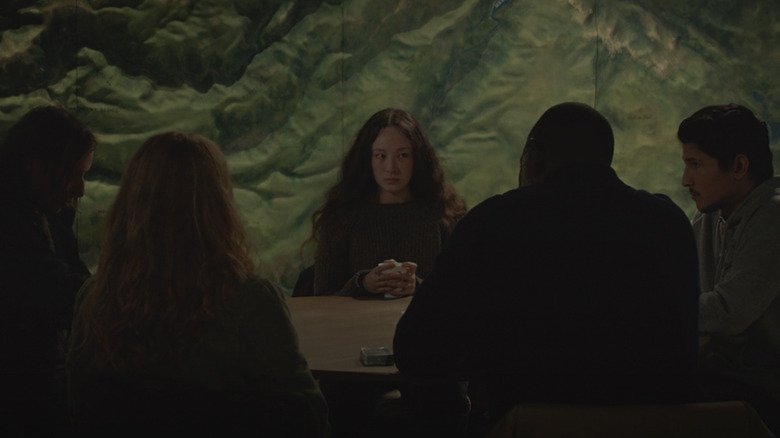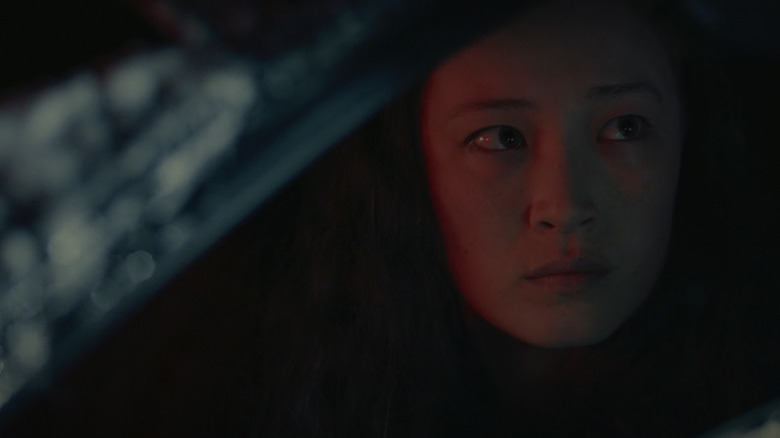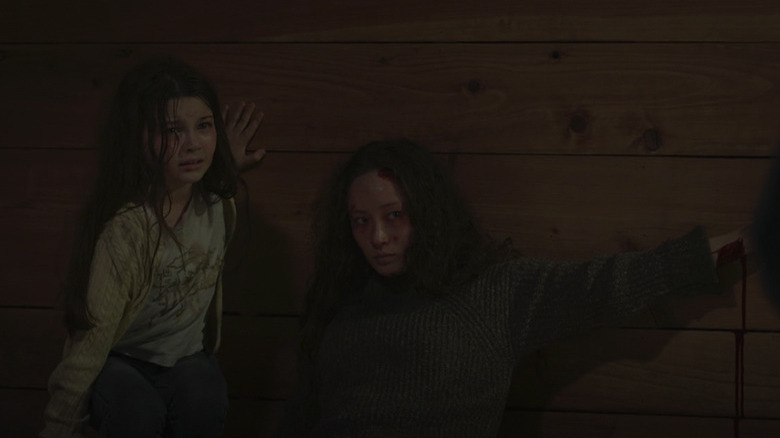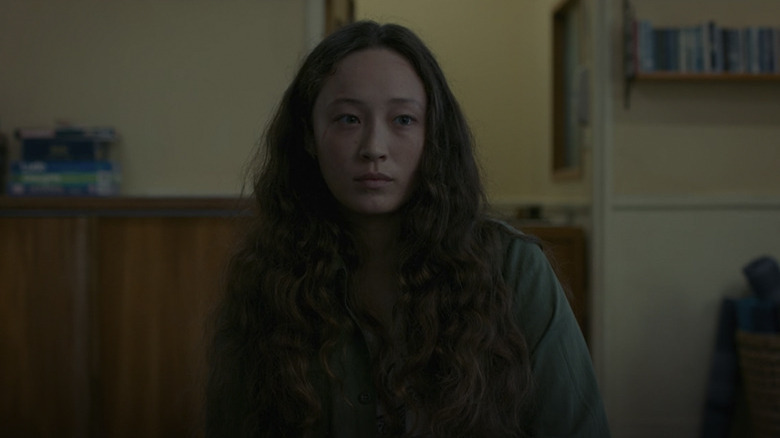No Exit Director Damien Power On Maintaining Tone And Valuing Suspense Over Gore [Interview]
When Damien Power, the filmmaker behind the taut little thriller "No Exit" that debuted on Hulu this past weekend, first read the script, he knew the approach he would take when the cameras rolled. "For me, it was all about playing it for real that it would feel experiential, that we would be following Darby through this journey," he told /Film, referencing the lead character played by Havana Rose Liu. That approach resulted in an effective and surprisingly nasty movie, one which takes its initial premise — who among a waylaid group of travelers is actually a kidnapper? — and continually throws obstacles at Darby, putting her through the physical and emotional wringer.
I spoke with Power about maintaining the tone he was trying to achieve, what he learned about his movie during the post-production process, and the practical methodology behind one of the movie's biggest set pieces. We talked about that latter point in great detail, so consider this a spoiler warning for the events of "No Exit."
'Never feels like you have the time when everybody's in the room'
When we spoke earlier, you told me that you looked at things like "Green Room" and "Prisoners" for inspiration. I was wondering if there were any films that you showed your cast to get them inspired or help inform their performances in any way. I spoke with Havana, and she told me how you guys really wanted to keep it focused on the humanity for the Darby character, but I'm wondering about anybody else, if you sent them any movies or anything to help.
I may have said to look at "Prisoners" and "Green Room," but I didn't actually sit anyone down and say, "Let's all watch this together." Never feels like you have the time when everybody's in the room. But I don't want people thinking about really other movies. I don't want the actors, particularly, thinking about other movies when they're to give a performance. I find other films useful as kind of visual references for the cinematographer or for the designer or so that we can talk about the look and the feel and the construction of the film. I find that's where those kind of references are most useful.
'I really feel like we made the most of that as a weapon'
I have to ask you about that "nail through the wrist" moment, because that is something I certainly was not expecting and it definitely lets you know that this movie is not messing around. So tell me about that moment. What was your reaction to it when you read it in the script for the first time, and then I want to know how you practically did it.
So actually, when I read it in the script and the novel, what happens in that moment is actually even more violent, believe it or not. Darby has to cut her own fingers off to escape, essentially, which was not something that I wanted to show or felt was necessary to show. Plus, there was already a nail gun in the story. It seemed to me pretty logical to make the best use of it possible in that moment. So we made that change fairly early on, and I really feel like we made the most of that as a weapon.
But also, when it came to actually filming it, I try to create a safe space for the actors so they're feeling comfortable with what they're doing. We built a practical set, so it was a real building. People could walk in and out of it. I tried to get us onto that set and rehearsing as much as I could. It wasn't always easy, because they were still finishing building it, but I remember coming in one weekend with the stunt coordinator, John Costello, and working through that whole scene where everything kind of explodes. I think one of the shocking things about that violence is that it seems to come out of nowhere, like real violence, and I very much wanted to play it for real. But having the opportunity to block it through, workshop it with everybody, in a pretty safe space that I could just kind of walk around to be filming stuff and talking to people was great, because then we all knew what worked, how it was going to work.
Then on the day, Havana and Danny, all of the cast, was so committed around those scenes and doing their own stunts and really giving of themselves and to the other actors. It was intense. Filming violence is some of the hardest stuff to do, and everyone was very sensitive to that. I think that you see in the film. Havana is extraordinary, I think, in terms of believing that she's just been nailed to a wall. It was incredible. Then in a practical sense, we had a rig built for her hand against the wall, although it turns out Havana's pretty good at holding her hand against the wall. So it was a mix of that and then when we got into post, we added in nails and blood with WETA, who did the effects.
So was it like a glove that she was able to slip her hand into or something that like secured it to the wall?
It was more like a kind of half sleeve that went at the back of her hand that she could rest her hand in. But it was attached to the wall at a single point so she could pivot as if she was just being held there by one point.
'I'm much more interested in suspense and tension than gore'
Maintaining tone is one of the director's biggest jobs, so did you think a lot before production started about how to manage this story's intensity as it progressed?
Yeah, for sure. I think you're right. I think tone is one of the hardest things to maintain. For me, it was all about playing it for real that it would feel experiential, that we would be following Darby through this journey. I think once you make that decision and if the film has violence in it, then it's going to feel a certain way, and I wanted it to feel that way. But also, at the same time, I'm much more interested in suspense and tension than gore. So, it's not terribly explicit in that regard and I was careful to keep it at a certain level because I want people to feel it as intense. But it feels intense because it's happening to characters that we care about, not because of what we're seeing. In fact, I think sometimes the more you see, the less you feel, the easier it is to switch off and start thinking about, "Oh, how did they do that?" or "That's a pretty great prosthetic." Kind of movie making tricks. I wanted to keep it very much focused on the characters.
When I speak with filmmakers, a phrase that sometimes comes up is that they "found the movie in post-production," and I'm curious if you learned anything about this movie during editing that you didn't know about it during production.
I think one of the things that I found interesting in post-production was actually how little dialogue you need. I don't think you need to understand a single word of this film to completely understand what's going on. I love it when that happens, and I love watching those films, but for me, I was surprised that it really does speak to a kind of primal level in that story and so much of it can be conveyed in looks without words. I think my favorite scene in the whole film, actually, is the moment where Jay appears from out of the van and everyone's sitting down at that table and it's all told in looks between these characters. There's a conversation going on where some characters are completely oblivious, but everyone else is — the scene is about, what is Darby going to do? She knows the consequences of intervening. She knows what's going to happen. Is she going to act? For me, it's just such a beautiful scene, watching those actors and the looks between them, and it's a kind of pivot point in the film, really, because once she takes that action, there is no turning back.
"No Exit" is currently streaming on Hulu.



